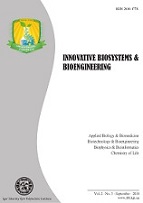Analysis of Fractional-Order Model of COVID-19 Pandemics With a Nonlinear Incidence Rate
DOI:
https://doi.org/10.20535/ibb.2020.4.3.206271Keywords:
SIR-modeling, modified Riemann–Liouville fractional operator, numerical simulations, COVID-19 outbreak, basic reproduction numberAbstract
Background. Several mathematical representations of contagious disease COVID-19 were evolved in order to capture the pragmatic aspect of unfurling of the disease. It is learned that individuals who became receptive were infected with a rate proportional to the fraction of the individuals affected by the infection, in the comprehensive population as well as the infected individuals recuperate at a sustained rate. It is also observed that in the SIR model, all contacts impart the disease with an identical probability.
Objective. We will estimate the dynamic epidemic behaviour of inflected population for India with the use of fractional-order SIR simulations and compare our results with the results obtained for extrapolated actual cases of the infected people.
Methods. We have obtained the approximate solutions of the fractional-order Susceptible-Infectious-Recovered model within the framework of the modified Riemann–Liouville fractional differential operator using a new iterative fractional complex transform technique.
Results. The optimal values of the fractional-order SIR model parameters were identified with the use of the New Iterative Method. The dynamic incident rate with high and low reproduction number is predicted as well as the illustrated graphical with actual data is provided. To sum, the fractional calculus model for a complex system proposed here is just an indication to show what might happen if we do not control the reproduction number in the community.
Conclusions. The control measures that have already been found like swift surveillance, quarantine and social distancing means, such as face masks and closures, assisted in curtailing coronavirus transmission – estimated by the average number of people each infected individual infects, or reproduction number, to close to the level of 1 in each month.
References
Kermack WO, McKendrick AG. A contribution to the mathematical theory of epidemics. Proceedings of the Royal Society of London. Series A, Containing Papers of a Mathematical and Physical Character. 1927;115(772):700-21. DOI: 10.1098/rspa.1927.0118
Cooke KL. Stability analysis for a vector disease model. Rocky Mountain Journal of Mathematics. 1979;9(1):31-42. DOI: 10.1216/RMJ-1979-9-1-31
Brauer F, Castillo-Chavez C. Mathematical Models in Population Biology and Epidemiology, vol. 40. New York, NY: Springer; 2012, 508 p. DOI: 10.1007/978-1-4614-1686-9
Grassly NC, Fraser C. Mathematical models of infectious disease transmission. Nature Reviews Microbiology. 2008;6(6):477-87. DOI: 10.1038/nrmicro1845
Vitanov NV, Ausloos MR. Knowledge epidemics and population dynamics models for describing idea diffusion. arXiv, 2012. Preprint. DOI: 10.48550/arXiv.1201.0676
Caputo M. Linear Models of Dissipation whose Q is almost Frequency Independent - II. Geophysical Journal International. 1967;13(5):529-39. DOI: 10.1111/j.1365-246X.1967.tb02303.x
Podlubny I. Fractional Differential Equations: An Introduction to Fractional Derivatives, Fractional Differential Equations, to Methods of their Solution and some of their Applications, vol. 198. San Diego: Academic Press; 1999, 340 p.
Diethelm K. The Analysis of Fractional Differential Equations: An Application-Oriented Exposition Using Differential Operators of Caputo Type, vol. 2004. Berlin, Heidelberg: Springer Berlin Heidelberg; 2010, 247 p. DOI: 10.1007/978-3-642-14574-2
Kilbas AA, Srivastava HM, Trujillo JJ. Theory and Applications of Fractional Differential Equations, vol. 204. Elsevier Science; 2006, 523 p.
Angstmann CN, Henry BI, McGann AV. A Fractional Order Recovery SIR Model from a Stochastic Process. Bulletin of Mathematical Biology. 2016;78(3):468-99. DOI: 10.1007/s11538-016-0151-7
Angstmann CN, Henry BI, McGann AV. A fractional-order infectivity SIR model. Physica A: Statistical Mechanics and its Applications. 2016;452:86-93. DOI: 10.1016/j.physa.2016.02.029
Hamdan NI, Kilicman A. A fractional order SIR epidemic model for dengue transmission. Chaos, Solitons & Fractals. 2018;114:55-62. DOI: 10.1016/j.chaos.2018.06.031
Mouaouine A, Boukhouima A, Hattaf K, Yousfi N. A fractional order SIR epidemic model with nonlinear incidence rate. Advances in Difference Equations. 2018;2018(1):160. DOI: 10.1186/s13662-018-1613-z
Wang X, Wang Z, Huang X, Li Y. Dynamic Analysis of a Delayed Fractional-Order SIR Model with Saturated Incidence and Treatment Functions. International Journal of Bifurcation and Chaos. 2018;28(14):1850180. DOI: 10.1142/S0218127418501808
Sene N. SIR epidemic model with Mittag-Leffler fractional derivative. Chaos, Solitons & Fractals. 2020;137:109833. DOI: 10.1016/j.chaos.2020.109833
Shaikh AS, Jadhav VS, Timol MG, Nisar KS, Khan I. Analysis of the COVID-19 Pandemic Spreading in India by an Epidemiological Model and Fractional Differential Operator. Preprints, 2020. Preprint. DOI: 10.20944/preprints202005.0266.v1
Oldham KB, Spanier J (eds.). The Fractional Calculus: Theory and Applications of Differentiation and Integration to Arbitrary Order, vol. 111. New York and London: Academic Press; 1974, 234 p.
Samko SG, Kilbas AA, Marichev OI. Fractional Integrals and Derivatives: Theory and Applications. Amsterdam: Gordon and Breach Science Publishers; 1993, 976 p.
Miller KS, Ross B. An Introduction to the Fractional Calculus and Fractional Differential Equations. New York: Wiley; 1993, 384 p.
Gorenflo R, Mainardi F. Fractional Calculus: Integral and Differential Equations of Fractional Order. In: Fractals and Fractional Calculus in Continuum Mechanics, vol. 378. Vienna: Springer Vienna; 1997, pp. 223-76. DOI: 10.1007/978-3-7091-2664-6_5
Jumarie G. Modified Riemann-Liouville derivative and fractional Taylor series of nondifferentiable functions further results. Computers & Mathematics with Applications. 2006;51(9-10):1367-76. DOI: 10.1016/j.camwa.2006.02.001
Li Z-B, He J-H. Fractional Complex Transform for Fractional Differential Equations. Mathematical and Computational Applications. 2010;15(5):970-3. DOI: 10.3390/mca15050970
Daftardar-Gejji V, Jafari H. An iterative method for solving nonlinear functional equations. Journal of Mathematical Analysis and Applications. 2006;316(2):753-63. DOI: 10.1016/j.jmaa.2005.05.009
Bhalekar S, Daftardar-Gejji V. Convergence of the New Iterative Method. International Journal of Differential Equations. 2011;2011(1):989065. DOI: 10.1155/2011/989065
Ministry of Health and Family Welfare, Government of India. Mohfw.gov.in. Available from: https://www.mohfw.gov.in/
Nesteruk I. Simulations and Predictions of COVID-19 Pandemic With the Use of SIR Model. Innovative Biosystems and Bioengineering. 2020;4(2):110-21. DOI: 10.20535/ibb.2020.4.2.204274
Downloads
Published
How to Cite
Issue
Section
License
Copyright (c) 2020 The Author(s)

This work is licensed under a Creative Commons Attribution 4.0 International License.
The ownership of copyright remains with the Authors.
Authors may use their own material in other publications provided that the Journal is acknowledged as the original place of publication and National Technical University of Ukraine “Igor Sikorsky Kyiv Polytechnic Institute” as the Publisher.
Authors are reminded that it is their responsibility to comply with copyright laws. It is essential to ensure that no part of the text or illustrations have appeared or are due to appear in other publications, without prior permission from the copyright holder.
IBB articles are published under Creative Commons licence:- Authors retain copyright and grant the journal right of first publication with the work simultaneously licensed under CC BY 4.0 that allows others to share the work with an acknowledgement of the work's authorship and initial publication in this journal.
- Authors are able to enter into separate, additional contractual arrangements for the non-exclusive distribution of the journal's published version of the work (e.g., post it to an institutional repository or publish it in a book), with an acknowledgement of its initial publication in this journal.
- Authors are permitted and encouraged to post their work online (e.g., in institutional repositories or on their website) prior to and during the submission process, as it can lead to productive exchanges, as well as earlier and greater citation of published work.









